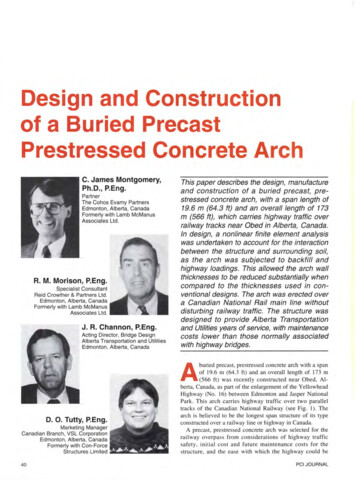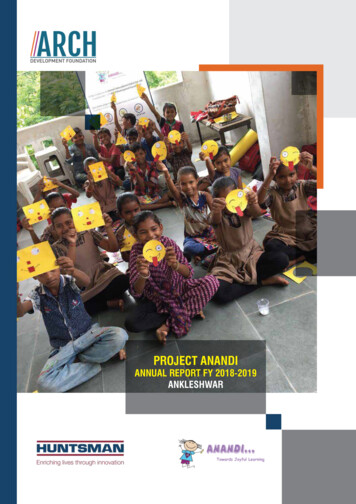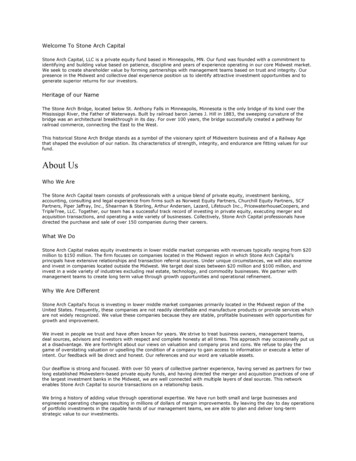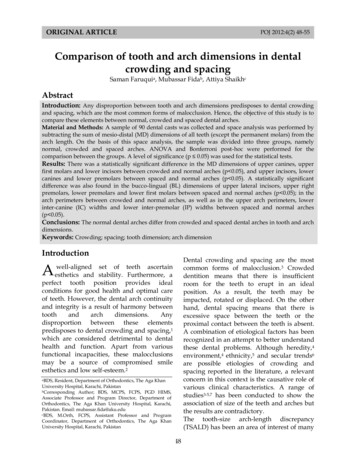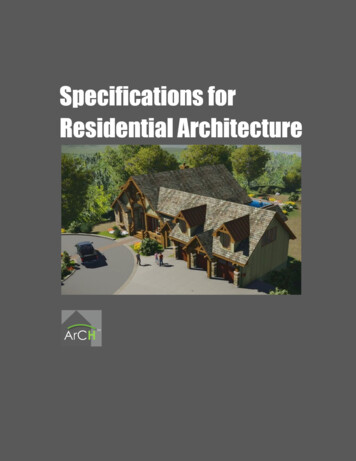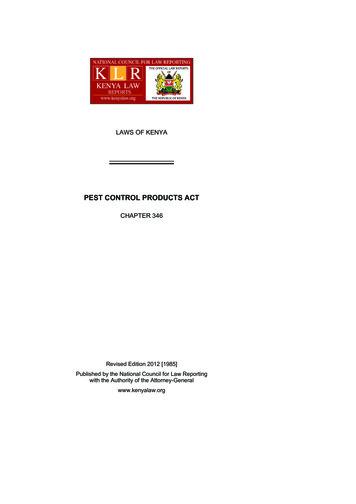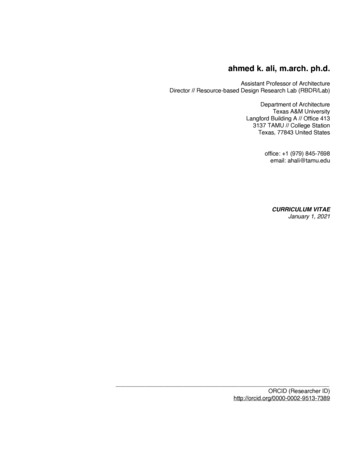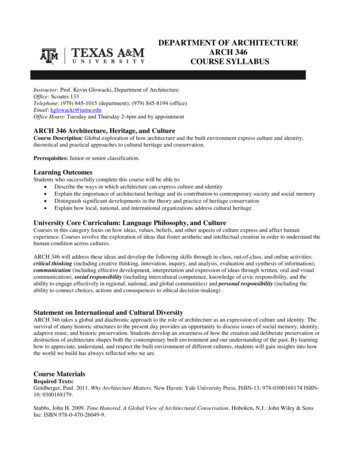
Transcription
DEPARTMENT OF ARCHITECTUREARCH 346COURSE SYLLABUSInstructor: Prof. Kevin Glowacki, Department of ArchitectureOffice: Scoates 133Telephone: (979) 845-1015 (department); (979) 845-8194 (office)Email: kglowacki@tamu.eduOffice Hours: Tuesday and Thursday 2-4pm and by appointmentARCH 346 Architecture, Heritage, and CultureCourse Description: Global exploration of how architecture and the built environment express culture and identity;theoretical and practical approaches to cultural heritage and conservation.Prerequisites: Junior or senior classification.Learning OutcomesStudents who successfully complete this course will be able to: Describe the ways in which architecture can express culture and identity Explain the importance of architectural heritage and its contribution to contemporary society and social memory Distinguish significant developments in the theory and practice of heritage conservation Explain how local, national, and international organizations address cultural heritageUniversity Core Curriculum: Language Philosophy, and CultureCourses in this category focus on how ideas, values, beliefs, and other aspects of culture express and affect humanexperience. Courses involve the exploration of ideas that foster aesthetic and intellectual creation in order to understand thehuman condition across cultures.ARCH 346 will address these ideas and develop the following skills through in-class, out-of-class, and online activities:critical thinking (including creative thinking, innovation, inquiry, and analysis, evaluation and synthesis of information),communication (including effective development, interpretation and expression of ideas through written, oral and visualcommunication), social responsibility (including intercultural competence, knowledge of civic responsibility, and theability to engage effectively in regional, national, and global communities) and personal responsibility (including theability to connect choices, actions and consequences to ethical decision-making) .Statement on International and Cultural DiversityARCH 346 takes a global and diachronic approach to the role of architecture as an expression of culture and identity. Thesurvival of many historic structures to the present day provides an opportunity to discuss issues of social memory, identity,adaptive reuse, and historic preservation. Students develop an awareness of how the creation and deliberate preservation ordestruction of architecture shapes both the contemporary built environment and our understanding of the past. By learninghow to appreciate, understand, and respect the built environment of different cultures, students will gain insights into howthe world we build has always reflected who we are.Course MaterialsRequired Texts:Goldberger, Paul. 2011. Why Architecture Matters. New Haven: Yale University Press. ISBN-13: 978-0300168174 ISBN10: 0300168179.Stubbs, John H. 2009. Time Honored. A Global View of Architectural Conservation. Hoboken, N.J.: John Wiley & SonsInc. ISBN 978-0-470-26049-9.
Texas A&M University Department of Architecture ARCH 346 Syllabus Kevin Glowacki page 2Supplemental Reading: Additional materials, including journal articles and encyclopedia entries, will be provided oneCampus.AssessmentExams: There will be three exams during the semester, two during class and one during the final exam period. Each examwill cover approximately four to five weeks of material presented in class and count for 20% of your final grade.In-class Assessment: ARCH 346 will develop teamwork skills through in-class activities, including minute papers,discussion in small groups, and analytical exercises. These activities will develop models for students to share individualperspectives with each other and to develop effective answers to questions that may appear on assignments andexaminations. Students will receive feedback from their peers as well as the instructor.Assignments: There will be three written assignments on topics presented in lecture and class discussion that address thelearning outcomes and core curriculum skills of the course. Each will count for 10% of your final grade.Reading Quizzes: There will be five reading quizzes given in class during the semester. Each will count for 2% of yourfinal grade.Grading Policy:Your grade will be calculated on the basis of the exams (3 x 20% 60%) assignments (3 x 10% 30%), and bi-weeklyreading quizzes (5 x 2% 10%). Grades will be posted on eCampus after each activity. Letter grades will be assignedaccording to the following guideline: A 90-100 (Excellent), B 80-89 (Good), C 70-79 (Satisfactory), D 60-69(Passing), F 59 and below (Failing), I Incomplete.Makeup Policy: Makeup exams will be given without question for excused absences as defined by University regulations.If you miss an exam for any other reason you may request a makeup, you will be allowed to take a makeup exam once. Themakeup exam may have a different format from that given in class, must be completed within one week of the originalexam date, and will be assessed a 10% penalty.Late Assignment Policy: Late assignments will be accepted without question for excused absences as defined byUniversity regulations. Any late assignments without an excused absence will accepted for a period of two days after thedue date and will be assessed a 10% penalty.Plagiarism Policy: According to the Texas A&M University Definitions of Academic Misconduct, plagiarism is theappropriation of another person’s ideas, processes, results or words without giving appropriate credit( http://aggiehonor.tamu.edu ). You should credit your use of anyone else’s words, graphic images, or ideas usingstandard citation styles. If I should discover that you have failed to properly credit sources or have used a paper written bysomeone else, I will recommend that you receive an F in this course. The Aggie Honor System Office processes foradjudication and appeals can be found at http://aggiehonor.tamu.edu.Texas A&M University Student Rules (http://student-rules.tamu.edu/)Attendance: Texas A&M views class attendance as an individual student responsibility. Attendance is essential tocomplete the course successfully. Material presented in lecture and class discussion may expand upon points only brieflyconsidered in the required text. University rules concerning excused absences may be found at http://studentrules.tamu.edu/rule07.Excused absences: A list of excused absences can be found in Student Rule 7.1 (http://studentrules.tamu.edu/rule07). Except for absences due to religious obligations, the student must notify his or her instructor in writing(acknowledged e-mail message is acceptable) prior to the date of absence if such notification is feasible. In cases whereadvance notification is not feasible (e.g., accident, or emergency) the student must provide notification by the end of thesecond working day after the absence. This notification should include an explanation of why notice could not be sent priorto the class. If the absence is excused, the instructor must either provide the student with an opportunity to make up anyquiz, exam or other graded activities or provide a satisfactory alternative to be completed within 30 calendar days from thelast day of the absence.
Texas A&M University Department of Architecture ARCH 346 Syllabus Kevin Glowacki page 3Excused Absences for Religious Holy Days: Texas House Bill 256 (effective 9/1/03) states “An institution of highereducation shall excuse a student from attending classes or other required activities, including examinations, for theobservance of a religious holy day, including travel for that purpose. A student whose absence is excused under thissubsection may not be penalized for that absence and shall be allowed to take an examination or complete an assignmentfrom which the student is excused within a reasonable amount of time after the absence.”Academic Integrity “An Aggie does not lie, cheat, or steal or tolerate those who do.” Upon accepting admission to TexasA&M University, a student immediately assumes a commitment to uphold the Honor Code, to accept responsibility forlearning, and to follow the philosophy and rules of the Honor System. Students will be required to state their commitmenton examinations, research papers, and other academic work. Ignorance of the rules does not exclude any member of theTAMU community from the requirements or the processes of the Honor System. For additional information please visit:http://aggiehonor.tamu.edu Each work that you turn in for this class must include your signature and the following statement. “On myhonor, as an Aggie, I have neither given nor received unauthorized aid on this academic work."Classroom Behavior Texas A&M University supports the principle of freedom of expression for both instructors andstudents. The university respects the rights of instructors to teach and students to learn. Maintenance of these rights requiresclassroom conditions that do not impede their exercise. Classroom behavior that seriously interferes with either (1) theinstructor’s ability to conduct the class or (2) the ability of other students to profit from the instructional program will notbe tolerated. An individual engaging in disruptive classroom behavior may be subject to disciplinary action. For additionalinformation please visit: http://student-rules.tamu.edu/rule21Americans with Disabilities Act (ADA) Policy StatementThe Americans with Disabilities Act (ADA) is a federal anti-discrimination statute that provides comprehensive civil rightsprotection for persons with disabilities. Among other things, this legislation requires that all students with disabilities beguaranteed a learning environment that provides for reasonable accommodation of their disabilities. If you believe you havea disability requiring an accommodation, please contact Disability Services, currently located in the Disability Servicesbuilding at the Student Services at White Creek complex on west campus or call 979-845-1637. For additional information,visit http://disability.tamu.edu.eCampusResources for ARCH 346 will be made available through eCampus including: Syllabus Lecture Handouts (with vocabulary, learning objectives, lecture outline and images) Writing assignment instructions, resources, and Turnitin submission link Course Readings Course Videos Study Guides for Exams GradesPlease log in at ecampus.tamu.edu. If you have technical difficulties accessing eCampus, please contact the Help Deskdirectly at 845-8300.Useful Links:Academic CalendarFinal Exam ScheduleTAMU CatalogStudent RulesAggie Honor System or.tamu.edu/
Texas A&M University Department of Architecture ARCH 346 Syllabus Kevin Glowacki page 4Schedule of Lectures, Reading Assignments, Writing Assignments, and ExamsPART ONE: WHY ARCHITECTURE MATTERSWEEK ONE: Course Introduction: Why Architecture MattersRequired Reading Goldberger, Paul. 2011. Why Architecture Matters, “Introduction” pp. ix-xvii. Stubbs, John H. 2009. Time Honored. A Global View of Architectural Conservation, Ch. 1, Introduction, pp. 3-19.WEEK TWO: Understanding Architecture and IdentityRequired Reading Goldberger, Paul. 2011. Why Architecture Matters, Chapter 1: “Meaning, culture and symbol,” pp. 1-40. National Park Service. “National Mall and Memorial Parks.” https://www.nps.gov/nama/index.htm .Case Studies: Washington D.C. and the National Mall***Reading Quiz #1 ***WEEK THREE: Buildings and “Place Making”Required Reading: Goldberger, Paul. 2011. Why Architecture Matters, Chapter 7: “Buildings and the Making of Place,” pp. 212-236. Woods, Mary N. 1985. “Thomas Jefferson and the University of Virginia: Planning the Academic Village.”Journal of the Society of Architectural Historians 44:3, pp. 266-283. World Heritage Center. “Monticello and the University of Virginia in Charlottesville.” http://whc.unesco.org/en/list/442 . Texas A&M University Campus Master Plan. http://campusplan.tamu.edu .Case Studies: University of Virginia and Jefferson’s “Academical Village” Texas A&M University: An Analysis of the Master PlanWEEK FOUR: Urban Culture and Historic City CentersRequired Reading: Lynch, Kevin. 1960. “The Image of the Environment.” In The Image of the City, pp. 1-13. Cambridge, MA: MITPress. World Heritage Center. “Historic Centre of Rome, the Properties of the Holy See in that City EnjoyingExtraterritorial Rights and San Paolo Fuori le Mura.” http://whc.unesco.org/en/list/91 . World Heritage Center. “Historic Centre of Florence.” http://whc.unesco.org/en/list/174 . World Heritage Center. “Imperial Palaces of the Ming and Qing Dynasties in Beijing and Shenyang.” http://whc.unesco.org/en/list/439 . World Heritage Center. “San Antonio Missions.” http://whc.unesco.org/en/list/1466 .Case Studies: Rome, Italy (ancient forum) Florence, Italy (Renaissance city) Beijing, China (Imperial and Forbidden City) San Antonio, TX (Alamo and Riverwalk)***Assignment One Due ***
Texas A&M University Department of Architecture ARCH 346 Syllabus Kevin Glowacki page 5WEEK FIVE: Symbolic Destruction/Suppression of IdentityReading: Schildgern, Brenda Deen. 2008. “Introduction: Destruction and Preservation: Continuities and Discontinuities.” InHeritage or Heresy. Preservation and Destructions of Religious Art and Architecture in Europe, pp. 1-20. NewYork: Palgrave Macmillan. Harmanşah, Ö. 2015. “ISIS, Heritage, and the Spectacles of Destruction in the Global Media.” Near EasternArchaeology 78:3 (Special Issue: The Cultural Heritage Crisis in the Middle East), pp. 170-177.***Exam One***PART TWO: ARCHITECTURE, MEMORY, AND CULTURAL IDENTITYWEEK SIX: Architectural “History” and Social MemoryReading: Goldberger, Paul. 2011. Why Architecture Matters, Chapter 5: “Architecture and Memory,” pp. 139-170.***Reading Quiz #2 ***WEEK SEVEN: Whose History is it?Reading: Stubbs, John H. 2009. Time Honored. A Global View of Architectural Conservation, Chapter 6, “Who Owns thePast?” pp. 71-90. World Heritage Center. “Monticello and the University of Virginia in Charlottesville.” http://whc.unesco.org/en/list/442 . Slavery at Jefferson’s Monticello: Paradox of Liberty ibertyslavery Case Study: Thomas Jefferson’s MonticelloWEEK EIGHT: The Secret Lives (and Afterlives) of Buildings: The Parthenon in Athens, GreeceReading: Dickinson, O. T. P. K., et al. “Athens.” Grove Art Online. Oxford Art Online. Oxford University Press. Ousterhout, Robert. 2005. “‘Bestride the Very Peak of Heaven’; The Parthenon after Antiquity.” In The Parthenonfrom Antiquity to the Present, edited by Jenifer Neils, pp. 293-330. Cambridge: Cambridge Univ. Press. Mallouchou – Tufano, Fani. 1994. “The History of Interventions on the Acropolis.” In Acropolis Restoration: theCCAM Interventions, edited by Richard Economakis, pp. 68-85. London: Academy Editions. Kynourgiopoulou, Vasiliki. 2011. “National Identity Interrupted: The Mutilation of the Parthenon Marbles and theGreek Claim for Repatriation.” In Contested Cultural Heritage, edited by Helaine Silverman, pp. 155-170. NewYork: Springer.***Assignment Two Due ***WEEK NINE: The Secret Lives (and Afterlives) of Buildings: The Hagia Sophia in Istanbul, TurkeyReading: Magdalino, Paul, et al. “Istanbul.” In Grove Art Online. Oxford Art Online. Oxford University Press. Necipoglu, Gülru. 1992. “The Life of an Imperial Monument: Hagia Sophia after Byzantium.” In The HagiaSophia: From the Age of Justinian to the Present, ed. Robert Mark, Ahmet Cakmak, pp. 195-225. Cambridge:Cambridge University Press. Aydingün, Şengül, and Rose Mark. 2003. “Saving a Fabled Sanctuary.” Archaeology 56, pp. 20-28.***Reading Quiz #3 ***
Texas A&M University Department of Architecture ARCH 346 Syllabus Kevin Glowacki page 6WEEK TEN: The Secret Lives (and Afterlives) of Buildings: The Mosque/Cathedral in Córdoba, SpainReading: Ruggles, D. Fairchild, et al. “Córdoba (i).” In Grove Art Online. Oxford Art Online. Oxford University Press. Schildgern, Brenda Deen. 2008. “Córdoba’s Mosque/Cathedral.” In Heritage or Heresy. Preservation andDestructions of Religious Art and Architecture in Europe, pp. 79-98. New York: Palgrave Macmillan. Ruggles, D. Fairchild. 2011. “The Stratigraphy of Forgetting: The Great Mosque of Cordoba and Its ContestedLegacy.” In Contested Cultural Heritage, edited by Helaine Silverman, pp. 51-67. New York: Springer.***Exam Two***PART THREE: APPROACHES TO CONSERVATION OF THE BUILT ENVIRONMENTWEEK ELEVEN: What Do We Conserve – and Why? Organizations and ChartersReading: Stubbs, John H. 2009. Time Honored. A Global View of Architectural Conservation, Chapter 3: “What Do WeConserve?” pp. 33-49; Chapter 15: “International Activities and Cooperation,” pp. 241-277. World Heritage Center. 2008. World Heritage Information Kit. http://whc.unesco.org/en/activities/567/ . International Council on Monuments and Sites (ICOMOS). “Missions and visions.” http://www.icomos.org/en/ . World Heritage Center. “Nubian Monuments from Abu Simbel to Philae.” http://whc.unesco.org/en/list/88 . Greenspan, A. 2009. Creating Colonial Williamsburg: The Restoration of Virginia’s Eighteenth-century CapitalChapel Hill, NC: University of North Carolina Press. Theobald, M. M. 2014. “African Americans and the Restoration of Williamsburg.” The Journal of the ColonialWilliamsburg Foundation 36:3, pp. 42-52. Case Studies:Abu Simbel and Philae (Egypt)Colonial Williamsburg, Virginia (USA)WEEK TWELVE: What Do We Conserve – and Why? Case StudiesReading: Stubbs, John H. 2009. Time Honored. A Global View of Architectural Conservation, Chapter 4: “Why ConserveBuildings and Sites?” pp. 51-63. World Heritage Center. “Angkor.” http://whc.unesco.org/en/list/668 . Fletcher, Roland, Ian Johnson, Eleanor Bruce and Khuon Khun-Neay. 2007. “Living with Heritage: SiteMonitoring and Heritage Values in Greater Angkor and the Angkor World Heritage Site, Cambodia.” WorldArchaeology 39:3 (The Archaeology of World Heritage), pp. 385-405. World Heritage Center. “Great Zimbabwe National Monument.” http://whc.unesco.org/en/list/364 . Fontein, Joost. 2006. “Silence, Destruction and Closure at Great Zimbabwe: Local Narratives of Desecration andAlienation.” Journal of Southern African Studies 32:4 (Heritage in Southern Africa), pp. 771-794.Case Studies: Angkor Wat (Cambodia) Great Zimbabwe (Zimbabwe)***Reading Quiz #4 ***WEEK THIRTEEN: What Do We Conserve – and Why? Sites of ConscienceReading: Sevcenko, Liz. 2004. The Power of Place: How Historic Sites Can Engage Citizens in Human Rights Issues.Minneapolis, MN: The Center for Victims of Torture, New Tactics in Human Rights Project.Case Studies: Lower East Side Tenement Museum, New York Slave House, Senegal District Six Museum, South AfricaGulag Museum, Russia
Texas A&M University Department of Architecture ARCH 346 Syllabus Kevin Glowacki page 7 Liberation War Museum, BangladeshTerezín Memorial, Czech RepublicDachau, Germany WWII Japanese American Internment Camps,United StatesEspacio Memoria y Derechos Humanos exEsma, Buenos Aires***Assignment Three Due ***WEEK FOURTEEN: Reflections on Architecture, Heritage and CultureReading: Schildgern, Brenda Deen. 2008. “Memory, Regret, and History: What is Cultural Heritage and Why Does itMatter?” In Heritage or Heresy. Preservation and Destructions of Religious Art and Architecture in Europe, pp.166-185. New York: Palgrave Macmillan.***Reading Quiz #5 ******Exam Three Final Exam**(See cheduling/Final-Exam-Schedule)
DEPARTMENT OF ARCHITECTURE ARCH 346 COURSE SYLLABUS Instructor: Prof. Kevin Glowacki, Department of Architecture Office: Scoates 133 Telephone: (979) 845-1015 (department); (979) 845-8194 (office) Email: kglowacki@tamu.edu Office Hours: Tuesday and Thursday 2-4pm and by appointment ARCH 346 Architecture, Heritage, and Culture
